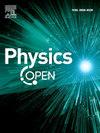New definitions of the effective nuclear charge and its application to estimate the matrix element ⟨n,l|rβ|n′,l′⟩
IF 1.4
Q2 Physics and Astronomy
引用次数: 0
Abstract
New definitions of the effective nuclear charge are proposed to evaluate the orbital wave function and the dipole matrix element for the non-hydrogenic atoms or ions. It is found that the commonly used effective nuclear charge defined by the orbital energy is insufficiently precise to estimate the orbital wave functions and matrix elements . Instead, the effective nuclear charge defined by or are more advantageous. It is shown that the effective nuclear charge method becomes increasingly precise to predict wave functions and matrix elements as the orbital angular momentum, the principle quantum number and the degree of ionization increase. Good accuracy is achieved when principal quantum numbers are identical or when both orbital quantum numbers and are non-zero. When -orbitals are involved ( or equal to zero) the precision is decreasing.
有效核电荷的新定义及其在估算矩阵元素⟨n,l|rβ|n′,l′⟩中的应用
提出了有效核电荷的新定义,以评估非氢原子或离子的轨道波函数和偶极矩阵元素⟨n,l|r|n′,l′⟩。研究发现,常用的由轨道能量定义的有效核电荷不足以精确估算轨道波函数和矩阵元素⟨n,l|r|n′,l′⟩。相反,由⟨r⟩或⟨r2⟩定义的有效核电荷更有优势。研究表明,随着轨道角动量、主量子数和电离程度的增加,有效核电荷法预测波函数和矩阵元素的精确度也越来越高。当主量子数相同 n=n′ 或轨道量子数 l 和 l′ 都不为零时,可以达到很高的精度。当涉及 s 轨道时(l 或 l′ 等于零),精确度会下降。
本文章由计算机程序翻译,如有差异,请以英文原文为准。
求助全文
约1分钟内获得全文
求助全文
来源期刊

Physics Open
Physics and Astronomy-Physics and Astronomy (all)
CiteScore
3.20
自引率
0.00%
发文量
19
审稿时长
9 weeks
 求助内容:
求助内容: 应助结果提醒方式:
应助结果提醒方式:


